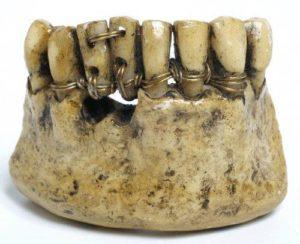Here’s an interesting statistic we ran across recently: Glidewell – a major dental lab based in Southern California – reports that over the past five years, the proportion of crowns made of porcelain fused to metal has dropped from 65% to just 20%. As the company’s director of clinical education told Dr. Bicuspid, “That’s a precipitous drop for a crown that was the default crown for crowns and bridges for 40 years. An amazingly rapid change in dentists’ prescribing habits.”
It’s also most welcome.
 Metals have have been used in dentistry since its earliest days, when the Etruscans were fashioning dentures held together with gold bands and wire, and Romans were filling decayed or broken teeth with lead. Gold fillings came into use some centuries later – roughly around the time that the German-Swiss scientist known as Paracelsus was writing about the effects of metals on the human body. (Today, he’s known as the father of toxicology and originator of the idea that “the dose makes the poison.”)
Metals have have been used in dentistry since its earliest days, when the Etruscans were fashioning dentures held together with gold bands and wire, and Romans were filling decayed or broken teeth with lead. Gold fillings came into use some centuries later – roughly around the time that the German-Swiss scientist known as Paracelsus was writing about the effects of metals on the human body. (Today, he’s known as the father of toxicology and originator of the idea that “the dose makes the poison.”)
Still, into the 19th century, lead was being used, along with a lead-tin alloy. Then mercury and silver fillings were introduced in the West. By mid-century, amalgam was in common use. Even then, many dentists were concerned about the use of mercury. They knew it was a poison. The American Society of Dental Surgeons opposed its use. A couple dozen members who objected split off to form the American Dental Association.
Their stance on mercury remains unchanged to this day. And we all know how well that’s gone.
Other metals continue to be used in conventional dentistry, as well. Titanium and aluminum are common in implants. Though gold has become largely cost-prohibitive, non-precious metals such as nickel and zinc are still used routinely in materials like amalgam and steel crowns.
Nickel, you should note, carries its own special problems. As Dr. Huggins writes, nickel
is the number one cancer stimulating metal, even worse than mercury – because mercury usually kills cells, whereas nickel just turns the cell malignant. Although cobalt and chromium individually do not cause cancer, if they are combined into one mixture, they will cause cancer.
Nickel causes DNA damage in preventing cells from repairing and from duplicating. It has pronounced adverse effects on the immune system, destroying T-cells and especially the NK cells that are our major defense against cancer. Alteration of chromosomes is another pastime of nickel.
Sounds pretty unsafe doesn’t it? But it’s cheap. That’s why we find it in removable partial dentures, orthodontic braces, adult crowns and bridges (especially as the base under porcelain crowns) and children’s “chrome crowns”….
Why have dentists insisted on using such materials when non-toxic, biocompatible alternatives are available? Habit probably has a lot to do with it. It’s what they were taught to do and what gets reinforced at many a seminar, class and conference. Most if not all of these materials are also much less technique sensitive than composite resins and new generation ceramics. They’re just easier to work with.
And many, unfortunately, are unaware of the systemic health issues that can be triggered or exacerbated by toxic or biologically inappropriate materials – or the galvanic currents generated when different metals come into close contact in the mouth.
For an excellent yet concise overview of these oral/systemic issues, check out this summary from ECC. For info on mercury in particular, you can’t do much better these days than the ever-growing research library at mercuryexposure.info.
So yes, it’s wonderful to see evidence that more dentists are foregoing metal, whether for aesthetic reasons or because today’s metal-free alternatives are proving extraordinarily safe, strong and durable. The newest composite resins routinely outperform mercury amalgam, even in the back teeth, which experience the greatest pressures of chewing, biting and swallowing. (Yes, when you swallow, your back teeth normally come together. Pay attention next time you swallow.)
 Zirconium and other ceramics have likewise proven worthwhile, guided by computer-aided design and manufacture, or what’s known as CAD-CAM technology. The CEREC unit we use in our office is of this nature. What’s more, it allows us to complete crowns in a single visit, since nothing has to be sent to the lab. The crowns are created right there in the office. And like composite restorations, they allow you to retain much more natural tooth structure, keeping your teeth as strong, solid and stable as possible.
Zirconium and other ceramics have likewise proven worthwhile, guided by computer-aided design and manufacture, or what’s known as CAD-CAM technology. The CEREC unit we use in our office is of this nature. What’s more, it allows us to complete crowns in a single visit, since nothing has to be sent to the lab. The crowns are created right there in the office. And like composite restorations, they allow you to retain much more natural tooth structure, keeping your teeth as strong, solid and stable as possible.
Indeed, we haven’t used metal in our office in years. The aesthetics of metal-free dentistry are great, of course, but health is the bottom line. It’s why Dr. Glaros insists on biocompatibility testing for every patient, as well.
When teeth need to be repaired due to breakage or decay, the treatment should always and only be an improvement, never a hindrance to health and well-being.